
Mastering AWS Incident Response: A Guide to Optimizing Your Cloud Security
Moving to the cloud offers incredible agility and scalability, but it also introduces a new landscape of security challenges. When a security incident occurs in your AWS environment, time is critical. A swift, well-orchestrated response can mean the difference between a minor issue and a catastrophic breach. That’s why having a robust AWS incident response (IR) plan isn’t just a best practice—it’s an operational necessity.
Optimizing your security operations for the cloud requires a shift in mindset away from traditional, on-premise security models. The dynamic and automated nature of AWS demands a proactive, intelligent, and highly automated approach to incident response.
Understanding the Cloud Security Paradigm
The foundation of AWS security is the Shared Responsibility Model. AWS is responsible for the security of the cloud (the hardware, software, and infrastructure that runs AWS services), while you are responsible for security in the cloud. This includes managing your data, configuring access controls, and securing your applications.
Your incident response plan must operate within this framework. You can’t physically unplug a server, but you have powerful tools to isolate resources, revoke credentials, and analyze activity at a massive scale.
The Core Phases of an Effective AWS Incident Response Plan
A successful IR plan is a continuous cycle, not a one-time checklist. Each phase is critical for building a resilient and secure environment.
1. Preparation: Building Your Defenses
This is the most crucial phase. What you do before an incident determines your success during one.
- Develop Clear Playbooks: Create step-by-step guides for common security scenarios, such as a compromised EC2 instance, data exfiltration, or unauthorized API activity.
- Establish Strong Identity and Access Management (IAM): Adhere to the principle of least privilege. Ensure users and services have only the permissions they absolutely need. Regularly audit and rotate credentials.
- Implement Comprehensive Logging and Monitoring: You cannot respond to what you cannot see. Enable and centralize logs from services like AWS CloudTrail, VPC Flow Logs, and DNS logs.
- Secure Your Infrastructure: Use security groups and network ACLs to control traffic. Encrypt data at rest and in transit using AWS Key Management Service (KMS).
2. Detection and Analysis: Identifying the Threat
Rapid detection is key to minimizing damage. The goal is to quickly identify malicious or anomalous activity and determine its scope.
- Leverage Managed Threat Detection: Amazon GuardDuty is an essential service that continuously monitors for malicious activity and unauthorized behavior using machine learning and threat intelligence.
- Analyze Audit Trails: AWS CloudTrail provides a detailed event log of every API call made in your account. During an incident, this is your primary source for understanding what actions an attacker took.
- Centralize Findings: Use AWS Security Hub to get a single, aggregated view of security alerts and compliance status from various AWS services and third-party tools. This prevents important alerts from being missed.
3. Containment: Stopping the Attack
Once a threat is confirmed, you must act immediately to prevent it from spreading.
- Isolate Affected Resources: For a compromised EC2 instance, this could mean changing its security group to deny all inbound and outbound traffic except for forensic access.
- Revoke and Rotate Credentials: If an access key or user account is compromised, immediately disable the key and rotate all potentially affected credentials.
- Take Forensic Snapshots: Before terminating a resource, take a snapshot of its EBS volume. This preserves the state of the disk for later forensic analysis without keeping the compromised system online.
4. Eradication and Recovery: Removing the Threat and Restoring Operations
After containing the threat, the next step is to remove it from your environment and safely restore services.
- Identify the Root Cause: Use the evidence gathered to understand how the attacker gained access and what vulnerabilities were exploited.
- Redeploy from a Known Good State: Avoid “cleaning” a compromised server. The best practice is to terminate the affected instance and redeploy a new one from a trusted, patched Amazon Machine Image (AMI).
- Patch and Harden: Apply necessary security patches and configuration changes to prevent a recurrence of the incident.
5. Post-Incident Analysis: Learning and Improving
The work isn’t over when the incident is resolved. This final phase is critical for strengthening your future security posture.
- Conduct a Blameless Post-Mortem: Hold a meeting with all involved teams to discuss what happened, what went well, and where improvements can be made.
- Update Your Playbooks: Refine your incident response plans based on the lessons learned.
- Implement Preventive Measures: Use the root cause analysis to drive long-term security improvements, whether it’s enhancing monitoring, updating IAM policies, or providing additional team training.
Automation: Your Secret Weapon in Cloud Security
In the cloud, speed and scale matter. Manually responding to every alert is inefficient and prone to error. Automating your response actions is a key differentiator for a mature cloud security program.
By combining services like Amazon GuardDuty, AWS Lambda, and AWS Step Functions, you can create automated remediation workflows. For example:
- A GuardDuty finding for cryptocurrency mining on an EC2 instance can automatically trigger a Lambda function.
- The Lambda function can instantly isolate the instance by modifying its security group, take a snapshot for forensics, and notify your security team via Slack or email.
This automated response contains the threat in seconds, far faster than a human could react, significantly reducing your organization’s risk exposure. Building a library of these automated responses is one of the most effective ways to optimize your security operations.
Source: https://aws.amazon.com/blogs/security/optimize-security-operations-with-aws-security-incident-response/








